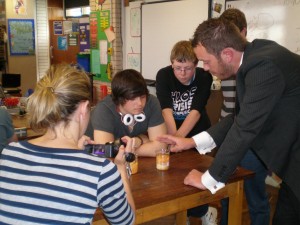
(Pictured with the year 12 students are Dan Roberts, Assistant Head and Jemma Woodman from COOL EARTH, who came in to film the students’ work.)
Last week as part of a unit of work looking at fermentation, a class of Yr12 completing the L3 BTEC in Forensic Science carried out a practical with a bit of a difference. The students complete a practical to brew beer so they can relate the theory to the small scale practical within the lab and then see how this is replicated on a much bigger scale in industry. (Don’t worry they don’t get to drink it! Although we have had suggestions of many names of beer that the school could produce particularly with the livetsock theme such as Dot’s drop after our pig Dorothy.) Now you would think that brewing beer would be very interesting to students although it hasn’t seemed to have that effect so we tried to be a bit more creative this time. Georgie Carey the Year 12 teacher came to see me for some ideas and I had just the thing. Whilst on my visit to Peru I spent some time with the Ashaninka people who taught me how to make the traditional beer called Masato or Pirrizi from the Manioc root.
However it is not exactly the same as the more traditional brewing methods that we are used to as the villagers in the mashing stage chew the manioc, as well as something more familiar the sweet potato. When they have been mixed with enough saliva they are then spat out back into the beer mixture. This is an integral part of the beer making process.
Watch the video here at the bottom of my home page: http://www.coolearth.org/379/cool-earth-schools-zone-36/teachers-168/dan-roberts-teacher-uk-896.html
Quite surprisingly we were able to source some Manioc in Plymouth which was quite a shock, the rest of the ingredients were fine we just needed some willing and able students to produce their own saliva – easy! The students then replicated the same Ashaninkan process within the classroom in Cornwall and then ‘transferred’ their saliva/beer mix to an appropriately scientific receptacle for the purposes of the experiment. After adding some water, the ‘delicious’ mix is now fermenting nicely in the classroom. Students were somewhat relieved to hear they would not be drinking the brew at any stage, just testing it to see the impact of the enzymes in saliva on the fermentation process! As a result of the planning to carry out these lessons Jemma Woodman from Cool Earth came down to film the students completing the practical. The lesson resources for this if you wanted to replicate it will be available on the Cool Earth Website in the Cool Schools part on my homepage. Here is one of the main resources too: http://drop.io/coolearth
Have you got any similar stories of bringing the outside world into the classroom? Please share these by leaving a comment.

wow when I read the title to your blog this is not what I expected lol. I was wondering why I havn’t been getting smarter when I go out 😉